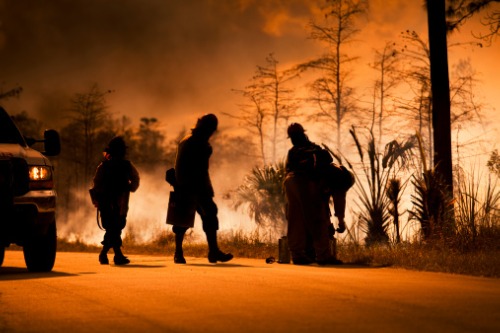

Climate change has risen to the top of the global agenda. For the first time ever, environmental and climate-related risks formed all of the World Economic Forum’s (WEF) top five threats to the global economy in the coming decade.
As detailed in the WEF Global Risks Report 2020, which compiles data from 750 risk experts and decision makers around the world, the most concerning long-term risks include: extreme weather events, the failure of climate-change mitigation, major natural disasters, the extinction of animal species, and human-made environmental damage.
With climate change fixed on the radar of corporate and civil risk managers around the world, more and more attention is being turned towards resilience and working out effective measures and solutions for global disaster loss reduction.
Greg Lowe, global head of resilience and sustainability at Aon, describes resilience as a triangle. There are three different components in the resilience triangle: financial resilience and physical resilience in the bottom two thirds, and institutional resilience sitting on top. The insurance and reinsurance industry is sat firmly in the financial resilience section of the triangle.
Lowe explained: “We help protect balance sheets from net volatility. They could be corporate balance sheets, sovereign balance sheets, or even the balance sheets of individual households. In addition to the protection that insurance provides in smoothing out that financial volatility, there’s the physical resilience part of the triangle. This is where engineers, architects, urban planners, and so on, play a very large role in the built environment and how that environment performs when we experience natural catastrophes.
“On top of all this sits institutional resilience, or you might want to call it social resilience. It’s that community bond and the strength of public institutions that actually respond to [disaster] events in a timely way. They’re also very much responsible for planning and education. I think sometimes the institutional resilience gets missed out in the broader discussion of resilience. The resilience triangle really requires a framework. There are many different components and some significant gaps.”
When it comes to resilience, the focus often falls on the financial section. There’s an idea that when a disaster strikes, the insurance and reinsurance industry will always be there to pick up the pieces. While this reflects a relatively good global understanding of insurance as a risk transfer mechanism, it also implies a lack of understanding and focus on effective disaster risk prevention and mitigation solutions, according to Lowe.
“We don’t really think enough about how we can plan beyond the use of insurance, retain more risk, and also use the data that the insurance industry has to better inform ways of making sure that insurance is a last resort, rather than something we just roll in as a crutch to get us through,” he commented. “I think it behooves us to think about how capital may be more sensitive to exposure to natural disaster. It’s largely driven by climate change, but I think these lessons apply to other types of hazards as well. We really need to identify the critical stakeholders to close some of the protection gap - the gap between insured and economic losses.
“First and foremost, we’re all familiar with the supply of capital. We certainly think of [insurance] as a supply of risk transfer capital, and that is indeed true. But our communities, our businesses are our national governments are also dependent on capital for their day to day functioning. This is really facilitated by ratings agencies, particularly S&P Global, who broke ground with this about five-years-ago around the relationship between natural catastrophe risk and how they’re thinking about sovereign debt rating. Moody’s has taken that forward to look at municipal bond ratings in the US as well. These sorts of macro-economic risks also have an impact on capital availability. Capital is incredibly important in the lubrication of our economic activity.”
In the physical resilience third of the triangle, the engineers and planners are the key stakeholders. It’s down to these stakeholders to conduct a future-ready engineering approach that’s prepared for changing climate risk, according to Lowe. He said that with the very apparent need to adapt our civilization to a changing climate, it’s imperative to adapt existing physical assets and also think about taking a modular approach to retrofitting assets that will need to evolve in stages.
“Then we come to the planning dimension,” Lowe added. “We need to think better about how we avoid some of the risk to begin with. In the case of climate risk, this is a very hotly debated topic. Do we actually think about moving people out of harm’s way? After the Canterbury earthquakes in New Zealand, there were actually neighborhoods that were red lined. I think it’s extremely difficult to do that before an event [but it is important for planners and engineers to] identify which areas are most exposed and most vulnerable, both in terms of physical vulnerability as well as some of the social vulnerabilities you may find in lower income areas.”
In terms of institutional resilience, Lowe identified first responders as some of the key stakeholders, not only because communities depend upon them when a disaster event happens but also in terms of how they communicate disaster resilience. Lowe commented: “I think that communication needs to be very visible even before events occur. That actually helps build that social piece of resilience, but that communication needs to be ongoing to remind people around the vulnerabilities and what they can do to help reduce those risks.”
